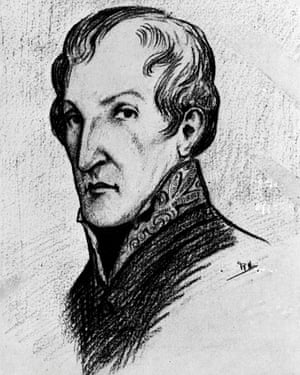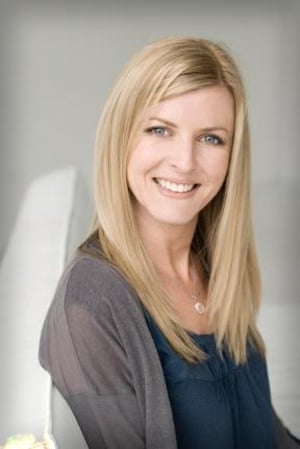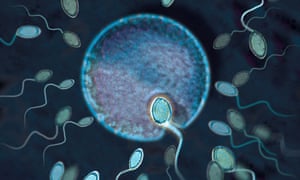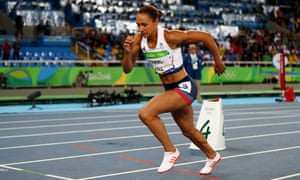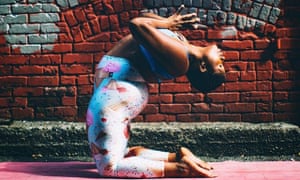We begin in darkness and head up towards the light. It is that time just before the dawn when it’s neither day nor night. Down near Lake Coniston, I can hear an owl and a curlew calling, both claiming the hour for themselves. “I like to come this early,” says Sion. “There’s no one else around. I can’t handle crowds. I get confused.”
It’s 4.30am and I am with Sion Jair, 67, and his partner, Wendy Kolbe, 63, and we are heading up the Old Man of Coniston, an 803-metre Lake District fell noted for its sharp ascent and great panoramas of southern lakeland. Or at least we hope so: there are some clouds massing in the east.
For Sion, this has become a daily ritual, adopted seven years ago when a visit to the doctor changed his life for ever. “I had been feeling permanently tired, and suffering some memory problems. It meant I couldn’t get out walking, you see, and when I can’t walk, I really shut down.”
After tests, the doctor diagnosed chronic anaemia from vitamin B12 deficiency. Injections usually sort that out, but Sion reacted badly to the shots and, without them, was given three years to live. Determined not to give in, he set about walking in earnest, covering around 10 miles a day. “Eventually, it worked. I reckon it cured me of the chronic fatigue,” he says.
But there was another blow. The anaemia had been masking signs of dementia. Given the particular type of condition he was suffering from, he was warned that he could expect periods of total memory loss, mood swings and eventually the inability to look after himself. Sion had become one of the estimated 25 million people worldwide suffering this progressive neurodegenerative disease, as feared now as the Black Death was in its day.
“It was quite scary,” says Sion, adding, in something of an understatement. “I didn’t like the idea.”
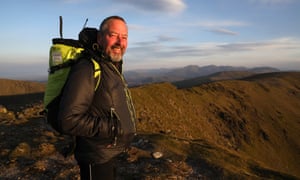
Sion’s response was typical of him: he walked even more. Not just the Old Man, but other fells, too: Scafell Pike, Helvellyn, Blencathra, Dollywaggon Pike – all the greats. “I’ve done them so often, I know them blindfolded.” And all this he did without any technological intermediaries, smartphone or GPS – just the steady rhythm of his feet. On one occasion he did 12 peaks and 28 miles in 22 hours, raising cash for his three favourite charities: the Alzheimer’s Society, Mountain Rescue and the Great North Air Ambulance. He also walked in Wales – he walked the Snowdon horseshoe more than 200 times – and Scotland, but it was in Coniston that he found his walking mantra. I suppose you could call it his Coniston Old Man-tra.
“I come twice a day sometimes. I know every part of the path, and lots of individual stones. I’ve done it more than 5,000 times, and hope to do it long into my illness. But I don’t call myself a walker – not at all – this is me. Me and the Lakes. I found a place where I fit in – I’ve become part of the landscape and it’s become part of me. It’s a kind of symbiosis.”
That is what fascinates me about Sion. His walking has embedded him in the Lakeland landscape and made him happy, despite the dementia. Like the Herdwick sheep grazing the hillsides, he has become hefted to the fell.
Walking, of course, is as familiar and mundane as breathing. Most of us do it all the time, and have done probably ever since the proto-human Sahelanthropus tchadensis walked across what is now the Djurab desert in Chad six or seven million years ago. The bones found there in 2001 are currently the oldest evidence for bipedalism, although that species was probably still a tree-climber, too. It was not until Homo erectus, a couple of million years ago, that two-legged locomotion finally became the method of travel that defines humans.
The act of walking, however, has come a long way since it was just about peeking over the elephant grass and carrying a big stick. It can take on a greater purpose and meaning than simply propelling yourself along. Think of the times you have walked a good distance and then looked back and marvelled at how far you’ve travelled. There is something magical and energising about gazing back over the ridges of misty fells, or even how many Tube stations you have passed. Great thinkers and writers, from Aristotle to Lakeland’s own William Wordsworth, have sworn by the power of walking. There is no possibility of cheating, no first-class option. When we walk, we are all equal. “Shank’s pony” is a great leveller. Perhaps that’s why we choose to protest by walking. A group protest march on foot carries the message that something is wrong with the outside world and needs to be put right. In that way, I think, Sion’s walking is a kind of solo protest march against an inner problem, his dementia. It’s his way of tackling it and refusing to surrender without a fight.
We are starting to climb more steeply now, and the track is a treacherous scree of loose, flat stones that make dull, hollow noises when kicked. “It’s hard,” he says, “talking and climbing.” But that doesn’t stop him. When we pass an abandoned slate quarry halfway up the mountain, he tells me how he once moved a wooden beam that was threatening to fall on some unsuspecting hikers. Beside that beam is some rusting winding gear. Perhaps it’s that – the metal wreckage of a former life – that triggers something in his head, because next thing he is telling me a childhood story from the 1950s. “I was out shopping with my mum and two RAF jet fighters collided overhead. I remember watching the fuselage of one jet smash into some houses. When we got home, our house had been hit, too. There was a big crack in the gable end.”
As if on cue, the sun breaks over the low bank of cloud and instantly spreads a fiery glow across the fell ridges and summits. Is this how it works, I wonder – walking triggers memories, then somehow they get tangled into the walk itself? Are the fells listening?
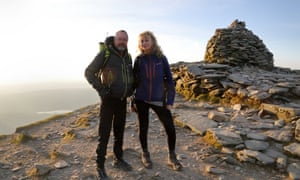
Sion is certainly an entertaining companion, and has an impish sense of humour. He is also a quick walker. He had said, at the bottom of the hill: “No one passes me on the fells.” By now I could understand why. With short, rapid strides, he gets into a rhythm and does not stop. Wendy is left behind, and I have to concentrate hard just to keep pace with him. His energy and power are astonishing.
Behind us the landscape begins to unfurl: the silver streaks of Lakes Windermere and Coniston, the silver eyes of Low Water and Levers Water. “It might get a bit windy here,” says Sion, and sure enough, within a few strides a cold blast comes roaring up the col, biting at us, and suggesting another story.
“Back in the late 60s and early 70s, I was a biker,” he says, chuckling. “I had long hair and rode a BSA Royal Star. One time me and a mate rode down to London from Birmingham on it – both of us with hair all down our backs. That was in the days when you didn’t have to wear a helmet, and of course we didn’t.” He stops to wipe away a tear that the wind has tugged from his eye. “When we stopped at a service station, we both got off the bike and immediately fell over. Our hair had got knotted together by the wind. It was crazy. I remember bystanders killing themselves laughing. We had to cut it with a knife.”
I ask if these kind of stories come back to him at other times – when just sitting at home in an armchair, for example.
“No. My mind shuts down and I get depressed. I need to walk, then it comes.”
Sion is walking his stories out, using the rhythm and swing of his legs to oxygenate his memory, triggering recollections. With dementia, he tells me, there is very little help in that difficult period between diagnosis and the dreaded moment when the sufferer can no longer cope. This is his self-administered treatment.
I ask about his past. Had he always lived in Cumbria? “I was in Birmingham for many years. I lived beside the M6 at Spaghetti Junction for 14 years.” Recent studies have suggested a link between pollution and dementia. Was there anything good about that? He grins. “I miss the sound of the birds coughing.”
He had gone through some bad times: redundancy, divorce and homelessness, but later he managed to get a housing association flat next to the notorious road intersection. The smell of diesel was ever-present. He was already struggling with chronic fatigue, and a doctor recommended he get away to somewhere with cleaner air – perhaps in the mountains. It was then that he recalled a teenage visit to an Outward Bound course in the Lakes. He telephoned a housing association in Cumbria and asked to do a swap. When they offered a place he took it immediately. He laughs. “They said: ‘Don’t you want to see it?’ I said: ‘No, that won’t be necessary.’”
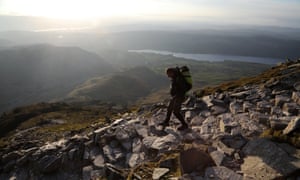
When he arrived in Ulverston, he looked out the front window and in the distance saw the Old Man, the fell that looms over Coniston village. The next day, he went up it. “I’ve always walked a lot. When I was going through divorce and redundancy, I walked to deal with my problems.”
As we reach the final summit ridge, he instinctively turns away from the wind and leads us to a place of shelter, then dons a thicker jacket. “We’ll not stop long at the top – it’s going to be too cold.” And that reminds him. “A lot of people come out now with GPS, but in cold weather the batteries don’t last as long. They forget that.” He doesn’t believe GPS helps. “It takes away skills like timing, pacing and contour-reading – skills that bring a feel for the landscape.” And beyond that, “I reckon they prevent people from building memories of places and routes, gathering all that knowledge and experience into a useful mental map.” This is something that is particularly significant for a dementia sufferer, and the evidence bears him out.
Soon after GPS first appeared in civil navigation, around the turn of the millennium, academics began noticing its adverse effect on mental maps, even damaging spatial awareness. In 2008 a Japanese researcher, Toru Ishikawa, showed that subjects given GPS rather than paper maps made more errors and travelled further. Other studies confirmed this and similar findings. No wonder there has been a spate of books on traditional navigational methods, such as John Huth’s The Lost Art of Finding Our Way, and Tristan Gooley’s The Walker’s Guide to Outdoor Clues & Signs. One area of the brain long thought to be associated with mental map-building is the hippocampus. Unsurprisingly perhaps, London cabbies who have done the Knowledge have been found to have larger hippocampus volumes. It is known that people with reduced hippocampus volumes are at a greater risk of developing conditions such as dementia. The science suggests that Sion is absolutely right in treating himself with large doses of mental map-building.
At the summit, we brace ourselves against the icy blast and gaze around. Wendy comes up and joins us. Sion names the fells and lakes. Northwards to Fairfield, Wetherlam and Scafell Pike; east to Low Water, the Coniston Fells and the Pennines. He has walked all these ridges, and knows every path and tarn. Not wanting that knowledge to be wasted, he and Wendy have started a not-for-profit venture to teach navigational skills using traditional map-and-compass methods. “We try to give people the confidence to be out here alone,” says Wendy.
It had seemed like a joke when I had asked Sion if there was anything he missed about Spaghetti Junction, but now I ask if there have been any benefits to his diagnosis of dementia. He laughs. “I can never remember who lent me money.” But then he thinks, his eyes twinkling. “You know, I think there is. I’ve learned to live every day as it comes. I do believe the walking is holding the dementia at bay a bit. And I’m up here in all weather, even Christmas Day. I love it. I’ve tuned in to the Lakes, and they’ve tuned in to me.”
Mountains of the mind: "I’ve become part of the landscape and it’s become part of me"
